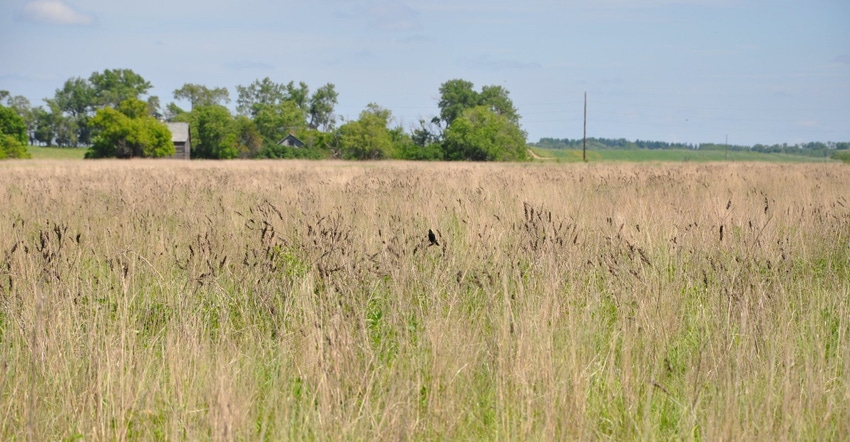
USDA is sweetening the deal on Conservation Reserve Program by increasing rental rates by 10% and trying to capitalize on the natural resource benefits. However, the higher rental rates drew concern from grain end users who say the action could limit overall production.
USDA has set a July 23, 2021, deadline for agricultural producers and landowners to apply for the CRP General signup 56. Additionally, USDA’s Farm Service Agency will accept applications for CRP Grasslands from July 12 to August 20. This year, USDA updated both signup options to provide improved incentives for producers and increase its conservation benefits, including reducing the impacts of climate change, the agency says.
FSA Administrator Zach Ducheneaux says, “Bottom line, CRP now makes more financial sense for producers while also providing a bigger return on investment in terms of natural resource benefits. The General and Grasslands signups are part of a broader suite of tools available through CRP to integrate key conservation practices on our nation’s working lands.”
Sign-up details
Through CRP, producers and landowners establish long-term, resource-conserving plant species, such as approved grasses or trees, to control soil erosion, improve water quality and enhance wildlife habitat on cropland. Lands enrolled in CRP also play a key role in mitigating impacts from climate change, and FSA has added a new Climate-Smart Practice Incentive for practices that sequester carbon and reduce greenhouse gas emissions.
FSA is also adding a one-time “inflationary” adjustment for payment rates, as well as having more flexibility on adjusting soil rental rates.
Related: USDA enhances CRP for climate mitigation
FSA opened the General Signup in January 2021 and extended the original deadline to July 23, 2021, to enable producers to consider FSA’s new improvements to the program.
FSA has updated the Grasslands signup to establish a minimum rental rate of $15 per acre, as well as new National Grassland Priority Zones. To enroll in the CRP Grasslands signup, they should contact USDA by the August 20 deadline.
Discouraging working lands
National Grain and Feed Association President and CEO Mike Seyfert says NGFA is supportive of working lands programs, including the Conservation Security Program and Environmental Quality Incentives Program, but expressed concerned with the proposals to expand CRP. NGFA believes USDA’s decision to offer CRP rental rates exceeding the statutory maximums by 10% will lead to enrollment of productive farmland.
“NGFA is deeply concerned with proposals to expand the CRP that will take significant acreage out of production and place the U.S. at a competitive disadvantage globally, while risking making it harder for beginning and socially disadvantaged farmers to compete on rental rates and gain access to land needed to expand their operations,” Seyfert says.
The 2018 farm law established the maximum CRP rental rates for land enrolled through general sign-ups at 85% of each county’s average cash rental rate and 90% for land enrolled under continuous CRP sign-ups. Congress established the maximum CRP rental rate levels to help ensure CRP is targeting marginal farmland and not competing with farmers for productive farmland.
“This decision also runs counter to signals from the market encouraging farmers to maintain and expand production,” adds Seyfert. “Programs that increase acreage idling in the United States weaken our food and agricultural supply chains and send market signals to competitors to plant more acres, resulting in negative climate and environmental impacts.”
CLEAR30 expansion
Landowners and agricultural producers currently enrolled in CRP now have a wider opportunity to enroll in a 30-year contract through the Clean Lakes, Estuaries, And Rivers initiative, called CLEAR30. USDA is expanding CLEAR30 – a water-quality focused option available through CRP – to be nationwide now.
Interested producers with CRP contracts expiring September 30, 2021, should sign up by August 6, 2021. CLEAR30 provides an opportunity for producers to receive incentives for a 30-year commitment to water quality practices on their CRP land, building on their original 10- to 15-year CRP contracts.
“Offering CLEAR30 in all states enables durable maintenance of conservation investments and enhanced stewardship of the land and waterways on a larger scale,” Ducheneaux says.
Originally, CLEAR30 was only available in the Great Lakes and Chesapeake Bay watersheds. Now, access is expanded to agricultural producers nationwide.
Eligible producers must have certain water quality benefitting practices currently enrolled under continuous CRP or through the Conservation Reserve Enhancement Program (CREP), under contracts that are expiring on September 30, 2021.
These Long-term contracts will help ensure that conservation impacts and benefits remain in place for 30 years, reducing sediment and nutrient runoff and, ultimately, algal blooms. Conservation in riparian areas also provides important carbon sequestration benefits. Traditional CRP contracts run from 10 to 15 years.
Annual rental payments for landowners who enroll in CLEAR30 will be equal to the current Continuous CRP annual payment rate plus a 20% water quality incentive and annual rate adjustment of 27.5%.
Emergency CRP haying and grazing
Meanwhile, Rep. Dusty Johnson, R-S.D., and Sens. John Thune, R-S.D., and Mike Rounds, R-S.D., urged Secretary of Agriculture Tom Vilsack to utilize his administrative authority to release CRP acres for emergency haying and grazing prior to August 1. The most recent U.S. Drought Monitor indicates that more than 95% of South Dakota is experiencing drought conditions.
“Emergency release of CRP for haying and grazing in the past has provided valuable feed in local areas in times of urgent need, many times keeping livestock operators from being forced to untimely liquidate their herds, without damaging the conservation, habitat, and wildlife benefits that CRP was designed to provide,” the legislators wrote. “We strongly urge you to consider using the administrative authority you have available, in coordination with the state technical committee, to release as many additional CRP acres as possible.”
About the Author(s)
You May Also Like






